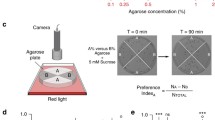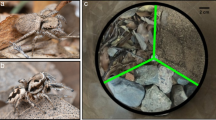Abstract
Leeches in the wild are often found on smooth surfaces, such as vegetation, smooth rocks or human artifacts such as bottles and cans, thus exhibiting what appears to be a “substrate texture preference”. Here, we have reproduced this behavior under controlled circumstances, by allowing leeches to step about freely on a range of silicon carbide substrates (sandpaper). To begin to understand the neural mechanisms underlying this texture preference behavior, we have determined relevant parameters of leech behavior both on uniform substrates of varying textures, and in a behavior choice paradigm in which the leech is confronted with a choice between rougher and smoother substrate textures at each step. We tested two non-exclusive mechanisms which could produce substrate texture preference: (1) a Differential Diffusion mechanism, in which a leech is more likely to stop moving on a smooth surface than on a rough one, and (2) a Smoothness Selection mechanism, in which a leech is more likely to attach its front sucker (prerequisite for taking a step) to a smooth surface than to a rough one. We propose that both mechanisms contribute to the texture preference exhibited by leeches.




Similar content being viewed by others
References
Adamiak-Brud Ż, Jabłońska-Barna I, Bielecki A, Terlecki J (2015) Settlement preferences of leeches (Clitellata: Hirudinida) for different artificial substrates. Hydrobiologia 758:275–286
Baltzley MJ, Gaudry Q, Kristan WB Jr (2010) Species-specific behavioral patterns correlate with differences in synaptic connections between homologous mechanosensory neurons. J Comp Physiol A 196:181–197
Belas R (2014) Biofilms, flagella, and mechanosensing of surfaces by bacteria. Trends Microbiol 22:517–527
Bisson G, Torre V (2011) Statistical characterization of social interactions and collective behavior in medicinal leeches. J Neurophysiol 106:78–90
Blackwell PG (1999) Random diffusion models for animal movement. Ecol Model 100:87–102
Blaesing B, Cruse H (2004) Stick insect locomotion in a complex environment: climbing over large gaps. J Exp Biol 207:1273–1286
Bush NE, Solla SA, Hartmann MJ (2016) Whisking mechanics and active sensing. Curr Opin Neurobiol 40:178–188
Carlton T, McVean A (1995) The role of touch, pressure and nociceptive mechanoreceptors of the leech in unrestrained behavior. J Comp Physiol A 177:781–791
Crisp KM, Gallagher BR, Mesce KA (2012) Mechanisms contributing to the dopamine induction of crawl-like bursting in leech motoneurons. J Exp Biol 215:3028–3036
Eck J, Kaas AL, Mulders JLJ, Goebel R (2013) Roughness perception of unfamiliar dot patterns. Acta Psych 143:20–34
Gaudry Q, Ruiz N, Huang T, Kristan WB 3rd, Kristan WB Jr (2010) Behavioral choice across leech species: chacun à son goût. J Exp Biol 213:1356–1365
Grant RA, Itskov PM, Towal RB, Prescott TJ (2014) Active touch sensing: finger tips, whiskers, and antennae. Front Behav Neurosci 8:50. https://doi.org/10.3389/fnbeh.2014.00050
Harley CM, Wagenaar DA (2014) Scanning behavior in the medicinal leech Hirudo verbana. PLoS One 9(1):1–7, e86120
Harley CM, English BA, Ritzmann RE (2009) Characterization of obstacle negotiation behaviors in the cockroach, Blaberus discoidalis. J Exp Biol 212:1463–1476
Harley CM, Cienfuegos J, Wagenaar DA (2011) Developmentally regulated multisensory integration for prey localization in the medicinal leech. J Exp Biol 214:3801–3807
Harley CM, Rossi M, Cienfuegos J, Wagenaar DA (2013) Discontinuous locomotion and prey sensing in the leech. J Exp Biol 216:1890–1897
Hollins M, Risner SR (2000) Evidence for the duplex theory of tactile texture perception. Percep Psychophys 62:695–705
Horne JS, Garton EO, Krone SM, Lewis JS (2007) Analyzing animal movements using Brownian bridges. Ecology 88:2354–2363
Jellies J (2014) Detection and selective avoidance of near ultraviolet radiation by an aquatic annelid: the medicinal leech. J Exp Biol 217:974–985
Kocer A (2014) Mechanisms of mechanosensing—mechanosensitive channels, function and re-engineering. Curr Opin Chem Biol 29:120–127
Kramer AP, Kuwada JY (1983) Formation of the receptive fields of leech mechanosensory neurons during embryonic development. J Neurosci 3:2474–2486
Kristan WB Jr (1982) Sensory and motor neurones responsible for the local bending response in leeches. J Exp Biol 96:161–180
Kristan WB Jr, Calabrese RL, Friesen WO (2005) Neuronal basis of leech behaviors. Prog Neurobiol 76:279–327
Kutschera U, Langguth H, Kuo D-H, Weisblat DA (2013) Description of a new leech species from North America, Helobdella austinensis n. sp. (Hirudinea: Glossiphoniidae), with observations on its feeding behaviour. Zoosyst Evol 89:239–246
Kuwada JY, Kramer AP (1983) Embryonic development of the leech nervous system: Primary axon outgrowth of identified neurons. J Neurosci 3:2098–2011
Lent CM (1985) Serotonergic modulation of the feeding behavior of the medicinal leech. Br Res Bull 134:643–655
Lewis JE, Kristan WB Jr (1998a) A neuronal network for computing population vectors in the leech. Nature 391:76–79
Lewis JE, Kristan WB Jr (1998b) Representation of touch localization by a population of leech touch sensitive neurons. J Neurophysiol 80:2584–2592
Neyman J, Pearson ES (1933) On the problem of the most efficient tests of statistical hypotheses. Phil Trans R Soc A: Math Phys Eng Sci 231:289–337
Nicholls JG, Baylor DA (1968) Specific modalities and receptive fields of sensory neurons in the CNS of the leech. J Neurophysiol 31:740–756
Nusbaum MP, Kristan WB Jr (1986) Swim initiation in the leech by serotonin-containing interneurons, cells 21 and 61. J Exp Biol 122:277–302
Palmer CR, Barnett MN, Copado S, Gardezy F, Kristan WB Jr (2014) Multiplexed modulation of behavioral choice. J Exp Biol 217:2963–2973
Pastor J, Soria B, Belmonte C (1996) Properties of the nociceptive neurons of the leech segmental ganglion. J Neurophysiol 75:2268–2269
Pirschel F, Kretzberg J (2016) Multiplexed population coding of stimulus properties by leech mechanosensory cells. J Neurosci 36:3636–3647
Puhl JG, Mesce KA (2008) Dopamine activates the motor pattern for crawling in the medicinal leech. J Neurosci 28:4192–4200
Sawyer R (1981) Leech biology and behavior, vol 1. Clarendon Press, Oxford
Shaw BK, Kristan WB Jr (1997) The neuronal basis of the behavioral choice between swimming and shortening in the leech: control is not selectively exercised at higher circuit levels. J Neurosci 17:786–795
Smouse PE, Focardi S, Moorcroft PR, Kie JG, Forester JD, Morales JM (2010) Stochastic modelling of animal movement. Philos Trans R Soc Lond B Biol Sci 365:2201–2211
Stern-Tomlinson W, Nusbaum MP, Perez LE, Kristan WB Jr (1986) A kinematic study of crawling behavior in the leech, Hirudo medicinalis. J Comp Physiol 158:593–603
Tiest WM (2010) Tactual perception of material properties. Vision Res 50:2775–2782
Willard A (1981) Effects of serotonin on the generation of the motor program for swimming by the medicinal leech. J Neurosci 1:936–944
Yau KW (1976) Physiological properties and receptive fields of mechanosensory neurones in the head ganglion of the leech: comparison with homologous cells in segmental ganglia. J Physiol 263:489–512
Acknowledgements
We thank Lidia Szczupak and members of the Weisblat lab for helpful comments on the manuscript. EACHH was supported by NIH NRSA F32 NS095665.
Author information
Authors and Affiliations
Corresponding author
Ethics declarations
Ethical approval
This article does not contain any studies with human participants or vertebrate animals performed by any of the authors.
Additional information
Publisher’s Note
Springer Nature remains neutral with regard to jurisdictional claims in published maps and institutional affiliations.
Electronic supplementary material
Below is the link to the electronic supplementary material.
Supplementary material 1 (MP4 84982 KB)
Rights and permissions
About this article
Cite this article
Kim, R.C., Le, D., Ma, K. et al. Behavioral analysis of substrate texture preference in a leech, Helobdella austinensis. J Comp Physiol A 205, 191–202 (2019). https://doi.org/10.1007/s00359-019-01317-5
Received:
Revised:
Accepted:
Published:
Issue Date:
DOI: https://doi.org/10.1007/s00359-019-01317-5




